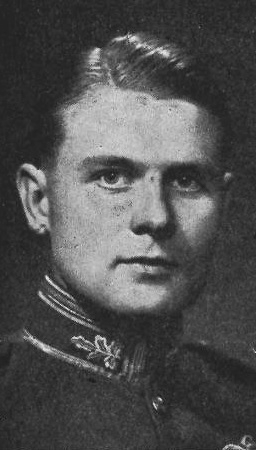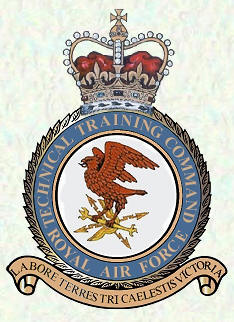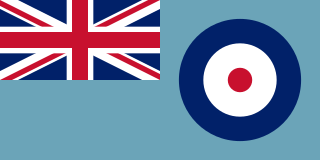
Air Chief Marshal Sir Wallace Hart Kyle, was an Australian who served in the Royal Air Force (RAF) as a senior commander and later as the 24th Governor of Western Australia. Born in Kalgoorlie, Western Australia, Kyle was commissioned into the RAF in 1929, and, having seen service in the Second World War and the Malayan Emergency, held a number of senior positions, including Vice-Chief of the Air Staff and commander-in-chief of the RAF's Bomber Command and Strike Command. He was made Governor of Western Australia in 1975, a position in which he served until 1980, later returning to England, where he died in 1988.

Royal Air Force Spitalgate or more simply RAF Spitalgate formerly known as RFC Grantham and RAF Grantham was a Royal Flying Corps and Royal Air Force station, located 2 mi (3.2 km) south east of the centre of Grantham, Lincolnshire, England fronting onto the main A52 road.

Marshal of the Royal Air Force Sir Thomas Geoffrey Pike, was a senior officer in the Royal Air Force. He served in the Second World War as a night fighter squadron commander and then as a station commander. He was Chief of the Air Staff in the early 1960s and, in that role, deployed British air power as part of the British response to the Brunei Revolt. Also, in the face of escalating costs, he implemented the cancellation of the British Blue Streak ballistic missile system but then found the RAF was without any such capability when the Americans cancelled their own Skybolt ballistic missile system. He went on to be Deputy Supreme Commander Supreme Headquarters Allied Powers Europe in the mid-1960s.

Marshal of the Royal Air Force Samuel Charles Elworthy, Baron Elworthy, was a senior officer in the Royal Air Force. He served as commander of a squadron of Blenheim bombers and then as a station commander during the Second World War. He became Chief of the Air Staff in the mid-1960s and implemented the cancellation of the TSR-2 strike aircraft and the HS681 military transport aircraft programmes. He also became Chief of the Defence Staff in which role he oversaw the evacuation from Aden in November 1967 and had to respond to the growing crisis in Northern Ireland in the late 1960s.

The Central Flying School (CFS) is the Royal Air Force's primary institution for the training of military flying instructors. Established in 1912 at the Upavon Aerodrome, it is the longest existing flying training school. The school was based at RAF Little Rissington from 1946 to 1976. Its motto is Imprimis Praecepta, Latin for "The Teaching is Everlasting".
Air Chief Marshal Sir Nigel Martin Maynard, was a senior Royal Air Force commander.

Training Command was the Royal Air Force's command responsible for flying and ground training from 1936 to 1940 and again from 1968 to 1977. Training Command was formed from RAF Inland Area on 1 May 1936 and absorbed into RAF Support Command on 13 June 1977. From 27 May 1940 to 1 June 1968, Training Command did not exist as its functions were split into Flying Training Command and Technical Training Command.

Air Chief Marshal Sir James Donald Innes Hardman,, known as Donald Hardman, was a senior Royal Air Force commander. He began his flying career as a fighter pilot in World War I, achieving nine victories to become an ace. During World War II, Hardman held senior staff and operational posts. He was Chief of the Air Staff (CAS) of the Royal Australian Air Force (RAAF) from 1952 to 1954, after which he served as a member of the British Air Council until retiring in 1958.

The RAF Staff College at RAF Andover was the first Royal Air Force staff college to be established. Its role was the training of officers in the administrative, staff and policy aspects of air force matters.

Air Marshal Sir Richard Llewellyn Roger Atcherley, was a senior Royal Air Force officer. He served as Commander-in-Chief of the Royal Pakistan Air Force from 1949 to 1951. His final appointment before retiring from the RAF was Air Officer Commanding-in-Chief of Flying Training Command.
Air Vice Marshal Henry Meyrick Cave-Browne-Cave, was an engineering officer in the Royal Naval Air Service during the First World War and senior commander in the Royal Air Force during the 1930s.
Royal Air Force Eastchurch or more simply RAF Eastchurch is a former Royal Air Force station near Eastchurch village, on the Isle of Sheppey, Kent, England. The history of aviation at Eastchurch stretches back to the first decade of the 20th century when it was used as an airfield by members of the Royal Aero Club. The area saw the first flight by a British pilot in Britain.

The Oxford University Air Squadron, abbreviated Oxford UAS, or OUAS, formed in 1925, is the training unit of the Royal Air Force at the University of Oxford and forms part of the Royal Air Force Volunteer Reserve. OUAS is one of fifteen University Air Squadrons that are spread out across Great Britain and it recruits from the universities at Oxford and Reading University.
Air Marshal Sir Leslie Dalton Morris, was a senior Royal Air Force (RAF) commander in the middle of the twentieth century. He played a leading role in the use of signals in the Air Force both during and after the Second World War.
Air Marshal Sir Paul Davie Holder, was a Royal Air Force officer who became Air Officer Commanding-in-Chief at RAF Coastal Command.

Technical Training Command was an organization within the Royal Air Force which controlled units responsible for delivering aircraft maintenance training and other non-flying training, initially in Berkshire and then in Cambridgeshire.
No. 6 Flying Training School RAF is a Flying Training School (FTS) within No. 22 (Training) Group of the Royal Air Force that delivers flying training to University Air Squadrons and Air Experience Flights.
At the end of the Cold War in 1989, the Royal Air Force (RAF) structure was as follows:

No. 21 Group RAF is a former Royal Air Force group that existed from April-July 1918; 1926-1934, a redesignation of No. 1 Group RAF; after which it was merged into Inland Area; and from 1938 to 1955.

No. 23 Group RAF was a group of the Royal Air Force, first established in 1918. It disbanded the same year but reformed during 1926 and finally disbanded for the second time in 1975.












